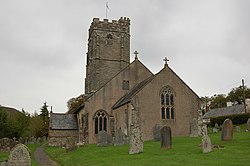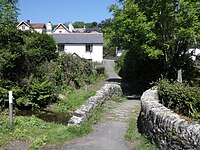Winsford, Somerset
| Winsford | |
| Somerset | |
|---|---|
 Church of St Mary Magdalene, Winsford | |
| Location | |
| Grid reference: | SS905345 |
| Location: | 51°5’57"N, 3°33’55"W |
| Data | |
| Population: | 321 (2011) |
| Post town: | Minehead |
| Postcode: | TA24 |
| Local Government | |
| Council: | Somerset West and Taunton |
| Parliamentary constituency: |
Bridgwater & W. Somerset |
Winsford is a village in Somerset, about five miles north-west of Dulverton, and around ten miles south-west of the coastal resort town of Minehead. It is within the Williton and Freemanners Hundred.
The name of the village comes from the ford across the Winn Brook, where it meets the River Exe.
The village has one hotel, The Royal Oak[1][2] dating to before the start of the 16th century, and one shop and post office. There is also a tea garden.
The village is on the route of the Samaritans Way South West and is located within the Exmoor National Park. To the east of the village is a connected hamlet, West Howetown.
Church
The parish church is dedicated to St Mary Magdalene. It is a mediæval church, which was partly restored in 1858.
The tower of the church, which stands 90 feet high,[3] was constructed in three stages. It contains six bells; the four heaviest were made by Thomas Bilbie in Cullompton in 1765.[4]
Within the church is a fine painted panel created in 1609 during the reign of King James I.[5] The ironwork on the inner doors of the church is thought to date from the 13th century, originating from the priory of St Nicholas in Barlynch, and the font is from the Norman period. The organ was installed c. 1900, being delivered by horse-drawn wagon from nearby Dulverton.[6] The church register dates back to 1660.[7]
The church is a Grade I listed building.[8]
History
Winsford Hill is the location of the Wambarrows, a number of Bronze Age burial sites, and Road Castle an Iron Age bank and ditch about two miles west from the village. The ditch is almost square in plan with rounded corners and covers an area of approximately 0.7 acres.[9]
Also by the viilage stands the Caratacus Stone, a standing stone bearing the inscription CARAACI NEPUS (lating for 'kinsman of Caratacus') possibly from the 5th century[10] and first documented in 1219.
The village appears in the Domesday Book of 1085, which lists the presence of 34 smallholders, 41 villagers, 52 sheep and 9 slaves, the whole area being capable of supporting 64 ploughs, despite 40 acres of it being woodland.[6]
Farms in the village include Nethercote, Staddon, Bradley, Halse, Upcott and Knaplock, all of which have retained their original names since tax records from 1327, during the reign of King Edward III.[6]
In the 17th century, Tom Faggus, a highwayman and a gentleman, was said to have held up travellers near the inn in Winsford.[11]
On 20 August 1907 the first registered sale and show of the Exmoor Horn Sheep Breeders' Society, which was founded a year earlier, was held in the village, and "1,200 ewes were sold by auction, at an average price per head of 42 shillings".[12]
In 1998 the Exmoor Community Computer Centre is a charitable trust took over the redundant building of the Winsford First School and established a community facility for social welfare and recreation.[13] This later became dormant and a grant was obtained for a community facilitator to help restart the centre and re-establishing the venue as a community resource. Computer courses have also been run at Porlock and Sampford Brett.[14]
In 2002 the body of an apparent murder victim was found on Winsford Hill. Despite extensive investigations it has yet to be identified.[15]
Geography
There are eight bridges, providing crossing points over the many small streams that run through the village; one is a packhorse bridge,[16][17][18][19][20] which is thought to be several hundred years old.[6] The Vicarage Bridge is 42 inches wide and 30 feet long.[21]
Winsford Common lies in a hollow in the surrounding countryside (which itself is within a valley), somewhat akin in shape to that of a punch bowl, and thus has gained the name of The Punchbowl. Given the shape and orientation of this deep hollow on the north-eastern edge of the extensive plateau of Winsford Hill and the nature of some of the deposits within it, it has been suggested that it was the site of what may have been the only glacier on Exmoor and indeed in south-western Britain during the Pleistocene ice ages.[22] It was a meeting point for the Tiverton hounds and Dulverton harriers.[7]
The subsoil of Winsford consists of rock shillet, whereas the topsoil has more of a clay-like and loamy character. Iron ore can be found in the mineral deposits of the village, and the mining of this was formerly important to Winsford's economy.
Garratts Wood covers a total area of two and three-qaurter acres. It is owned and managed by the Woodland Trust.[23]
Outside links
| ("Wikimedia Commons" has material about Winsford, Somerset) |
References
- ↑ National Heritage List 1295888: Karslake House
- ↑ National Heritage List 1295855: The Royal Oak Inn
- ↑ Leete-Hodge, Lornie (1985). Curiosities of Somerset. Bodmin: Bossiney Books. pp. 61–63. ISBN 0-906456-98-3.
- ↑ Moore, James; Rice, Roy; Hucker, Ernest (1995). Bilbie and the Chew Valley clock makers. The authors. ISBN 0-9526702-0-8.
- ↑ "Winsford". Everything Exmoor. http://www.everythingexmoor.org.uk/exmoor-encyclopedia/contents-list/56-w/1095-winsford.html. Retrieved 12 November 2010.
- ↑ 6.0 6.1 6.2 6.3 "Winsford". Everything Exmoor. http://www.everythingexmoor.org.uk/_W/Winsford.php. Retrieved 3 October 2007.
- ↑ 7.0 7.1 "Winsford". GENUKI. http://www.genuki.org.uk/big/eng/SOM/Winsford/index.html. Retrieved 3 October 2007.
- ↑ National Heritage List 1174169: Church of St Mary Magdalene
- ↑ National Monuments Record: No. 35715 – Road Castle
- ↑ Bush, Robin (1994). Somerset: The complete guide. Wimborne, Dorset: Dovecote Press. ISBN 1-874336-27-X.
- ↑ "Exmoor National Park". Equinetourism. Archived from the original on 30 November 2007. https://web.archive.org/web/20071130060823/http://www.equinetourism.co.uk/editorial/exmoorridinginfo.asp. Retrieved 6 July 2009.
- ↑ "History of the breed". Exmoor Horn Sheep Breeders' Society. http://www.exmoorhornbreeders.co.uk/history.htm. Retrieved 3 October 2007.
- ↑ "Exmoor Community Computer Centre". Exmoor Community Computer Centre. Archived from the original on 18 April 2010. https://web.archive.org/web/20100418155915/http://www.winsfordcentre.org.uk/. Retrieved 14 May 2010.
- ↑ "Exmoor Computer Centre — Winsford". Somerset Rural Renaissance. http://www.somerset-rural-renaissance.co.uk/projects-exmoor-computer-centre-winsford.html. Retrieved 14 May 2010.
- ↑ Alder, Chris (17 September 2006). "Mystery body to be laid to rest". somersetcountygazette.co.uk. Somerset County Gazette. http://www.somersetcountygazette.co.uk/news/920591.mystery_body_to_be_laid_to_rest/. Retrieved 13 October 2011.
- ↑ National Heritage List 1295874: Edbrooke Bridge
- ↑ National Heritage List 1174159: Packhorse bridge
- ↑ National Heritage List 1345401: Packhorse bridge
- ↑ National Heritage List 1174193: Packhorse bridge
- ↑ National Heritage List 1174205: Vicarage Bridge
- ↑ Hinchliffe, Ernest (1994). Guide to the Packhorse Bridges of England. Cicerone. pp. 153–154. ISBN 978-1852841430.
- ↑ Harrison,S. and Keen, D.H. in lewis, C.A. and Richards, A.E. 2005 The glaciations of Wales and adjacent areas Logaston Press, Bristol
- ↑ "Garratts Wood - a Woodland Trust Wood". Woodland Trust. http://www.woodlandtrust.org.uk/en/our-woods/Pages/wood-details.aspx?wood=4251. Retrieved 2 August 2012.
